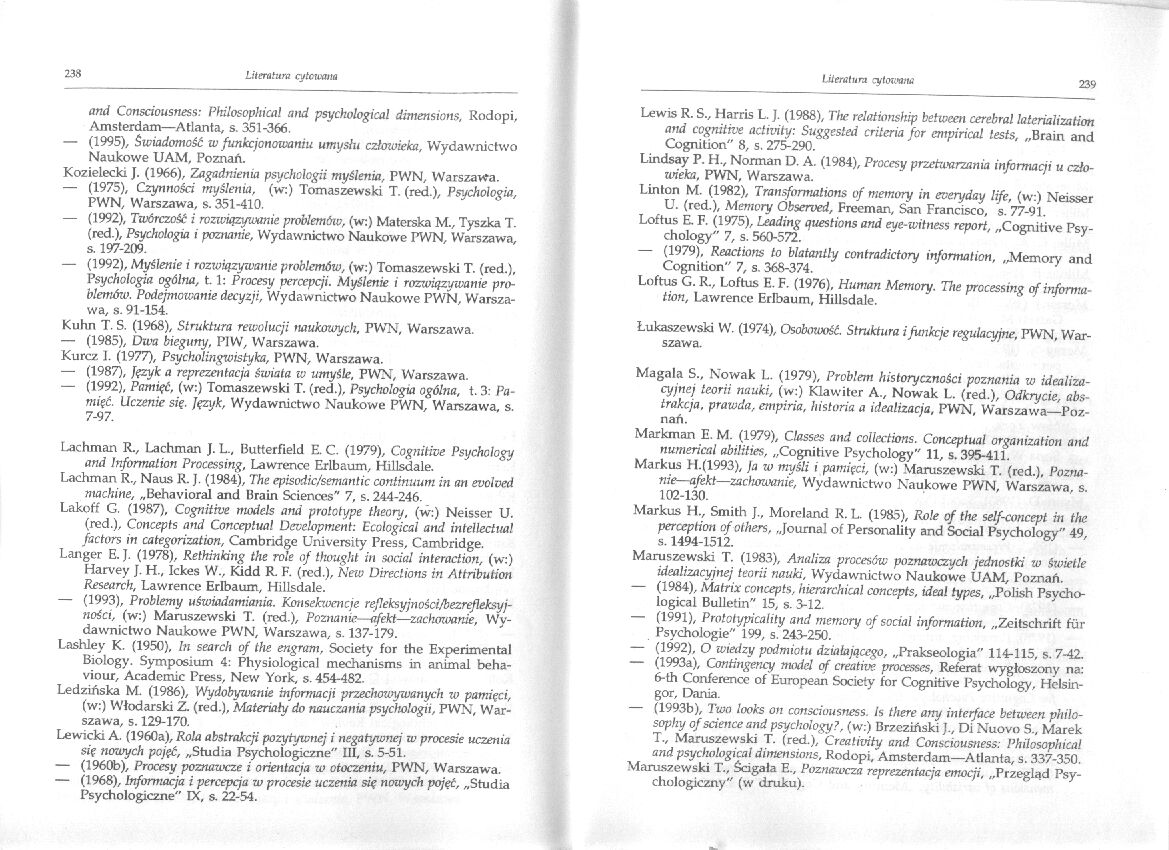238 239 (5)

238 Literatura cytcwma
and Consciousness: Philosophical and psychological dimensions, Rodopi, Amsterdam—Atlanta, s. 351-366.
— (1995), Świadomość w funkcjonowaniu umysłu człowieka. Wydawnictwo Naukowe U AM, Poznań.
Kozielecki J. (1966), Zagadnienia psychologii myślenia, PWN, Warszawa.
— (1975), Czynności myślenia, (w.) Tomaszewski T. (red.), Psychologia, PWN, Warszawa, s. 351-410.
— (1992), Twórczość i rozwiązywanie problemów, (w.) Matcrska M., Tyszka T. (red.), Psychologia i poznanie, Wydawnictwo Naukowe PWN, Warszawa, s. 197-209.
— (1992), Myślenie t rozwiązywanie problemów, (w:) Tomaszewski T. (red.). Psychologia ogólna, 11: Procesy percepcji. Myślenie i rozwiązywanie prm blemów. Podejmowanie decyzji, Wydawnictwo Naukowe PWN, Warszawa, s. 91-154.
Kuhn T. S. (1968), Struktura rewolucji naukowych, PWN, Warszawa.
— (1985), Dwa bieguny, PIW, Warszawa.
Kurcz I. (1977), Psycholingwistyka, PWN, Warszawa.
— (1987), Język a reprezentacja świata w umyśle, PWN, Warszawa.
— (1992), Pamięć, (w:) Tomaszewski T. (red.), Psychologia ogóltia, t. 3: Pamięć. Uczenie się. Język, Wydawnictwo Naukowe PWN, Warszawa, s. 7-97.
Lachman R., Lachman J. L., Butterfield E. C. (1979), Cognitioe Psychology and Information Processing, Lawrencc Erlbaum, Hillsdale.
Lachman R., Naus R. J. (1984), The episodic/semantic continuum iti an evolved machinę, „Behavioral and Brain Sciences" 7, s. 244-246.
Lakoff G. (1987), Cognitwe models and prolotype theory, (w:) Neisser U. (red.), Concepts and Conceptual Deoelopment: Ecologicai and intełlectua! factors in categorization, Cambridge University Press, Cambridge.
Langer E. J. (1978), Rethinking the role of thought in sodal interactioti, (w:) Harvey J. H., Ickes W., Kidd R. F. (red.), hlew Direclions in Attńbution Research, Lawrencc Erlbaum, Hillsdale.
— (1993), Problemy uświadamiania. Konsehoencje refleksyjności/bezrefleksyi-tiośct, (w:) Maruszcwski T. (red.), Poznanie- -afekt—zachoioanie, Wydawnictwo Naukowe PWN, Warszawa, s. 137-179.
Lashley K. (1950), In search oj the engram, Society for the Experimental Biology. Symposium 4: Physiological mechanisms in animal beha-viour, Academic Press, New York, s. 454-482.
Ledzińska M. (1986), Wydobywanie informacji przechowywanych w pamięci, (w:) Włodarski Z. (red.), Materiały do nauczania psychologu, PWN, Warszawa, s. 129-170.
Lewicki A. (1960a), Rola abstrakcji pozytywnej i negatywnej w procesie uczenia się nowych pojęć, „Studia Psychologiczne" III, s. 5-51.
— (1960b), Procesy poznawcze i orientacja w otoczeniu, PWN, Warszawa.
— (1968), Informacja i percepcja w procesie uczenia się nowych pojęć, „Studia Psychologiczne" IX, s. 22-54.
Lewis R. S., Harris L. J. (1988), The relationship between cerebral laterialization and cognitwe activity: Suggested criicria for empirical lests, „Brain and Cognition" 8, s. 275-290.
Lindsay P. H., Nonnan D. A. (1984), Procesy przetwarzania informacji u czło-iweka, PWN, Warszawa.
Linton M. (1982), Transformalions of memory in eoeryday life, (w:) Neisser U. (red.), Memory Óbserued, Freeman, San Francisco, s. 77-91.
Loftus E F. (1975), Leading ąuestions and eye-witness report, „Cognitive Psy-chology" 7, s. 560-572.
— (1979), Reactians to blatantly contradictory Information, „Memory and Cognition" 7, s. 368-374.
Loftus G. R., Loftus E. F. (1976), Humań Memory. The prccessing of informa-tion, Lawrencc Erlbaum, Hillsdale.
Łukaszewski W. (1974), Osobowość. Struktura i funkcje regulacyjne, PWN, Warszawa.
Magala S., Nowak L. (1979), Problem historyczności poznania w idea liżący jnej teorii nauki, (w:) Klawi ter A., Nowak L. (red.), Odkrycie, abstrakcja. prawda, empiria, historia a ideatizacja, PWN, Warszawa—Poznań.
Markman E. M. (1979), Classes and collections. Conceptual organization and numerical abilities, „Cognitwe Psychology" 11, s. 395-411.
Markus H.(1993), fa w myśli i pamięci, (w:) Maruszewski T. (red.), Pozna-nie—afekt—zachowanie, Wydawnictwo Naukowe PWN, Warszawa, s. 102-130.
Markus H., Smith ]., Moreland R. L. (1985), Role of the self-concept in the perccption ofothers, „Journal of Personality and Social Psychology" 49, s. 1494-1512.
Maruszewski T. (1983), Analiza procesów poznawczych jednostki w świetle idealizacyjnej teorii nauki, Wydawnictwo Naukowe U AM, Poznań.
— (1984), Matrix concepts, hierarchical concepts. ideał typcs, „Polish Psychological Bulle tin" 15, s. 3-12.
— (1991), Prolotypicality and memory of social Information, „Zeitschrift fur Psychologie" 199, s. 243-250.
— (1992), O wiedzy podmiotu działającego, „Prakseologia" 114-115, s. 7-42.
— (1993a), Contingency model of creatioe processcs, Referat wygłoszony na: 6-th Conference of European Socicty for Cognitive Psychology, Hclsin-gor, Dania.
— (1993b), Tioo looks on consduusness. Is there any interface between philo-sophy of science and psychology?, (w:) Brzeziński)., Di Nuovo 5., Marek T., Maruszewski T. (red.), Creatiuity and Consciousness: Philosophical and psychological dimensions, Rodopi/Amsterdam—Atlanta, s. 337-350.
Maruszewski T., Ścigała E., Poznawcza reprezentacja emocji, „Przegląd Psychologiczny" (w druku).
Wyszukiwarka
Podobne podstrony:
00236 ?44d42d312bc68c022745b1ad4e5b39 238 Baxley Yourstone, S. A., and Montgomery, D. C. (1990). “D
Basilisk : a journal of film, architecture, philosophy, literaturę, musie and perception BAT : art,
BEYONDPHILOLOGY AN INTERNATIONAL JOURNAL OF LINGUISTICS, LITERARY STUDIES AND ENGLISH LANGUAGE
within the scope of Polish language and literaturę, mathematics, and a subject chosen by the applica
prom zdr 8 10 11 (1) LITERATURA OBOWIĄZUJĄCĄ 1. And ruszę w i cz A. Banaszkiewicz
K_U01 The student can obtain information from literaturę, databases and other sources, in English or
44 A. EJCHART PIŚMIENNICTWO CYTOWANE [1] H. Friebolin, Basic One- and Two-Dimensio
Symposium of Somatotherapy and Psychosomatic Education. Man-Medicine-Culture. Kraków, 22-24 October
12 (33) Schachter S. & Singer .1. (1962) Cognitive, social and psychological determinants of emo
Particular lectures contents Number of hours 1. Kinematics: two and three dimensi
LITERATURA 1. BEZPIECZEŃSTWO PRACY I ERGONOMIA: tom I: Możliwości psychofizyczne
and operational dimensions. They will know how to identify, model, implement, direct and control as
THE IDEOLOGICAL AND CULTURAL DIMENSIONS OF HAGIOGRAPHY IN SOUTH-EAST EUROPE, PARTICULARLY IN TH
3 The Ideological and Cultural Dimensions 135 M.V. Esbroeck, in: The Byzantine Saint, 1981, pp.
5 The Ideological and Cultural Dimensions 137 history, this is treated “hagiologically” (Russia
9 The Ideological and Gultural Dimensions 141 secretis (AnBoll, 19, 1—2, 1981, p. 40: “whitened
11 The Ideological and Cultural Dimensions 143 “Ignatios the Deacon in both his ideological gui
13 The Ideological and Cultural Dimensions 145 sed after his death by miracles that occurred ne
15 The Ideological and Cultural Dimensions 14? translations and not in the original /Greek/ tex
więcej podobnych podstron